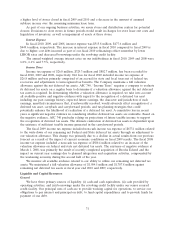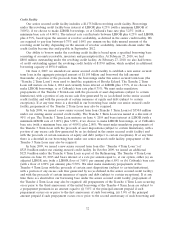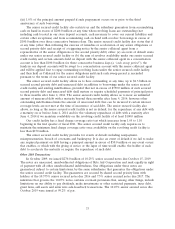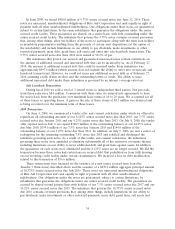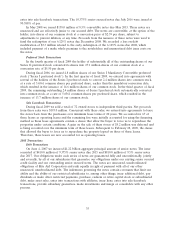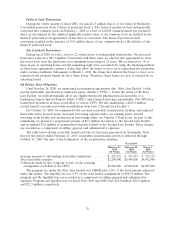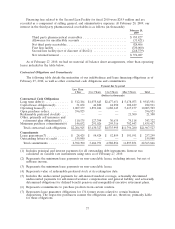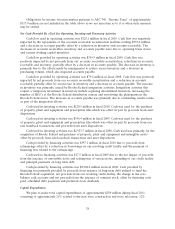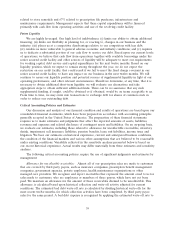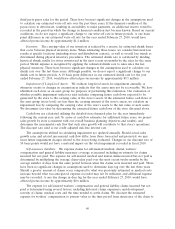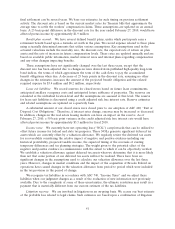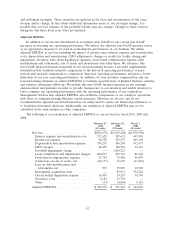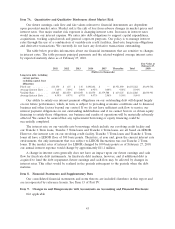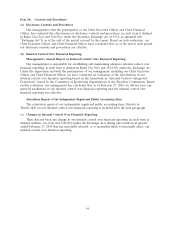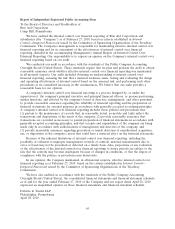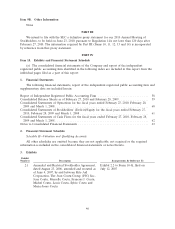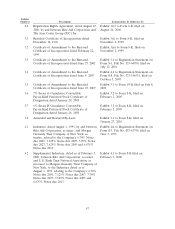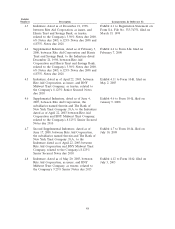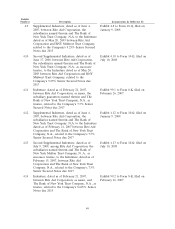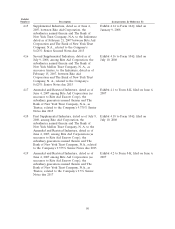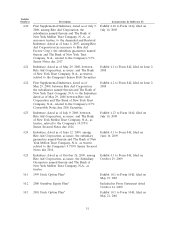Rite Aid 2010 Annual Report Download - page 41
Download and view the complete annual report
Please find page 41 of the 2010 Rite Aid annual report below. You can navigate through the pages in the report by either clicking on the pages listed below, or by using the keyword search tool below to find specific information within the annual report.final settlement can be several years. We base our estimates for such timing on previous settlement
activity. The discount rate is based on the current market rates for Treasury bills that approximate the
average time to settle the workers’ compensation claims. These assumptions are updated on an annual
basis. A 25 basis point difference in the discount rate for the year ended February 27, 2010, would have
affected pretax income by approximately $1.9 million.
Benefit plan accrual: We have several defined benefit plans, under which participants earn a
retirement benefit based upon a formula set forth in the plan. We record expense related to these plans
using actuarially determined amounts that utilize various assumptions. Key assumptions used in the
actuarial valuations include the mortality rate, the discount rate, the expected rate of return on plan
assets and the rate of increase in future compensation levels. These rates are updated annually and are
based on available public information, market interest rates and internal plans regarding compensation
and any other changes impacting benefits.
These assumptions have not significantly changed over the last three years, except that the
discount rate has been adjusted due to changes in rates derived from published high-quality long-term
bond indices, the terms of which approximate the term of the cash flows to pay the accumulated
benefit obligations when due. A decrease of 25 basis points in the discount rate, assuming no other
changes in the estimates, increases the amount of the projected benefit obligation and the related
required expense by $3.4 million and $0.2 million, respectively.
Lease exit liabilities: We record reserves for closed stores based on future lease commitments,
anticipated ancillary occupancy costs and anticipated future subleases of properties. The reserves are
calculated at the individual location level and the assumptions are assessed at that level. The reserve
for lease exit liabilities is discounted using a credit adjusted risk free interest rate. Reserve estimates
and related assumptions are updated on a quarterly basis.
A substantial amount of our closed stores were closed prior to our adoption of ASC 420, ‘‘Exit or
Disposal Cost Obligations.’’ Therefore, if interest rates change, reserves may be increased or decreased.
In addition, changes in the real estate leasing markets can have an impact on the reserve. As of
February 27, 2010, a 50 basis point variance in the credit adjusted risk free interest rate would have
affected pretax income by approximately $3.3 million for fiscal 2010.
Income taxes: We currently have net operating loss (‘‘NOL’’) carryforwards that can be utilized to
offset future income for federal and state tax purposes. These NOLs generate significant deferred tax
assets which are currently offset by a valuation allowance. We regularly review the deferred tax assets
for recoverability considering the relative impact of negative and positive evidence including our
historical profitability, projected taxable income, the expected timing of the reversals of existing
temporary differences and tax planning strategies. The weight given to the potential effect of the
negative and positive evidence is commensurate with the extent to which it can be objectively verified.
We establish a valuation allowance against deferred tax assets when we determine that it is more likely
than not that some portion of our deferred tax assets will not be realized. There have been no
significant changes in the assumptions used to calculate our valuation allowance over the last three
years. However, changes in market conditions and the impact of the acquisition of Brooks Eckerd on
operations have caused changes in the valuation allowance from period to period which were included
in the tax provision in the period of change.
We recognize tax liabilities in accordance with ASC 740, ‘‘Income Taxes’’ and we adjust these
liabilities when our judgment changes as a result of the evaluation of new information not previously
available. Due to the complexity of some of these uncertainties, the ultimate resolution may result in a
payment that is materially different from our current estimate of the tax liabilities.
Litigation reserves: We are involved in litigation on an on-going basis. We accrue our best estimate
of the probable loss related to legal claims. Such estimates are based upon a combination of litigation
41


